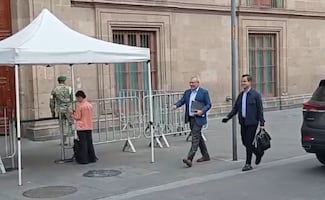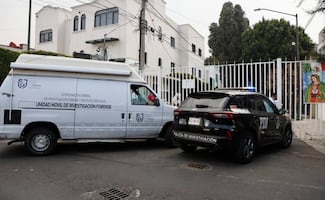Más Información

Senador del PT propone crear televisión, radio y periódico de la 4T; debemos hacer frente a medios de derecha, dice

César Duarte comparece ante jueza en penal del Altiplano; buscan vincularlo por presunto lavado de dinero

¿Qué es el Tratado de Aguas de 1944 entre México y EU por el que Trump amaga con imponer aranceles?; te explicamos

Gobernador de Michoacán se reúne con Sheinbaum en Palacio Nacional; acude también gabinete de Seguridad

Posponen en el Senado discusión y votación de reforma para crear la figura de “jueces sin rostro”; se discutirá en febrero

VIDEO Hallan a pareja sin vida en colonia Lindavista; una de las víctimas era abogado que litigó temas de despojos en Ecatepec
A lot of “humble, imploring, ignored women, temporarily fused in anonymity and by the end of their heroic acts, go unnoticed for many” wrote Francisco Monterde García Icazbalceta in the pages of EL UNIVERSAL ILUSTRADO back in 1923.
“This awakening of women in the 19th century took place when their activities were limited to the domestic sphere and in 1810, they reacted with energy and conviction, took smart decisions, and occupied the place of men who were fighting,” asserts doctor in history Guadalupe Jiménez.
210 years after the beginning of Mexico’s Independence War we remember the women who fought along with men, were in charge of the supply of food and weapons or carried out espionage tasks for which they were imprisoned or shot.

The most popular
In 1910, Josefa Ortiz de Domínguez (1768-1829) and Leona Vicario (1789-1842) were recognized during the Porfirio Díaz administration during the celebrations in regard to the 100th anniversary of the Mexican Independence.
La Corregidora, as doña Josefa is also known, is the “heroine of the Mexican Independence, the promoter of the rebellion discovered in Querétaro that unleashed Miguel Hidalgo’s liberation movement in 1810,” as mentions the text Women in Mexico’s civil life, edited by the Interior Ministry.
“There were more women who are not mentioned in the meetings with Hidalgo at La Corregidora’s house; there were interested in the country where they lived, the conditions in which they were, and what was going to happen to the New Spain,” says historian Javier Torres.

Leona Vicario de Quintana Roo (1789-1842) “contributed with confidential information and her wealth to support the liberation movement,” as stated in the aforementioned book.
Javier Torres adds: “Before her death, there was an attempt to recognize her as part of the movement and several newspapers and politicians, including Carlos María Bustamante, questioned Leona Vicario’s participation.”
Carlos María de Bustamante said that Vicario had only been involved in the Independence movement to follow the lead of her husband, Andrés Quintana Roo. This made Vicario write a public letter explaining she was accountable and had decided to join the movement by herself.

The lesser-known heroines
There are other lesser-known heroines, such as Antonia Nava, La Generala, and Catalina González, although their names are written in gold letters at the Wall of Honor of the House of Representatives.
Both of them were willing to sacrifice their body to feed the starving soldiers under General Nicolás Bravo at the Sierra de Xaliaca or Tlacotepec, Guerrero when there were no supplies left.
Luis González Obregón says in his text Heroines of the Independence, that when the general ordered to decimate his soldiers so that the others could eat, La General presented herself to Bravo along with several women and told him: “We came because we have found the way to be useful to our country. We cannot fight but we can nourish!”
“Here are our bodies that can be distributed as food for the soldiers.” This action encouraged the troops to keep fighting, so the sacrifice was not necessary.

The one who plotted against the viceroy
More than two centuries ago, Mariana Rodriguez del Toro was about to achieve Mexico’s Independence by scheming a plot against viceroy Francisco Xavier Venegas but was denounces and all the conspirators were arrested. Her properties were seized and she was left in absolute poverty. She was imprisoned in a dungeon for 10 years.
Recommended:
The ones who died at the scaffold
Gertrudis Bocanegra de Lazo de La Vega, the Pátzcuaro Heroine, was shot dead at the Pátzcuaro Square in Michoacán on October 10, 1817, over espionage crimes. She gave her life to the Realist Army for conspiracy against the Spanish government, according to a note to commemorate her published in this newspaper on October 10, 1971.

Luisa Martínez was shot at the cemetery of the Erongarícuaro Parrish in Pátzcuaro, Michoacán, in 1817. The reason: delivering news, foods, and economic resources to the rebels who participated in the Independence War.

The femmes fatales
Some women were accused of being “troops seducers,” a crime that makes reference to those who tried to convince soldiers and officials to defect.
María Tomasa Estévez was one of them. She worked for several rebel chiefs. One of her tasks consisted of collecting confidential information from the Spanish Realist Army and establishing the first Insurgent front in Salamanca, Guanajuato, along with Andrés Delgado, Albino García, and priest Rafael Garcilita.
Due to her persuasion, the Realist soldiers accused her of convincing some of their members to defect, so she was shot in Salamanca, Guanajuato in August 1814.
Carmen Camacho was accused of “seducing the Realist troops” and was shot on December 6, 1811. Before dying, she cheered the Mexican Independence, according to chronicler González Obregón.
Other women who were imprisoned included Gertrudis Armendáriz de Hidalgo y Costilla, Manuela Herrera, Prisca Marquina de Ocampo, and Altagracia Mercado.
The ones who fought with firearms
Some of those women who directly participated in the fight, used weapons, and had a military rank or produced magazines were María Fermina de Rivera, Altagracia Mercado, Prisca Martina de Ocampo, Manuela Medina (a quien la Junta de José María Morelos le dio el título de capitana), Carmen de las Piedras de Elías, las hermanas Francisca, and Magdalena Godos.
Recommended:
The ones who financed the movement
Some of the women who helped the Independence movement with money, food, or arms were Leona Vicario, Luisa Martínez, Gertrudis Bocanegra, Gertrudis Armendáriz de Hidalgo y Costilla, and María Petra Teruel de Velasco.
Manuela Herrera did not cooperate with resources but set her ranch on fire so that the Realists would not use it against the Insurgence in Hidalgo.
We must also mention the “Patriotas Marianas,” comprised of women who supported the Realist troops and that were called like that because they defended the interests of the Spanish King.
Two centuries have passed since the beginning of the Independence War and not all the female protagonists of the movement are mentioned in the celebrations and symbols of the heroic act.

Josefa Ortiz de Domínguez is the only woman named in the speech given by Mexican presidents on September 15, along with Hidalgo, Morelos, Allende, Aldama, Galeana, Matamoros, and Guerrero, among others.
“Historical speeches always mention the figure of the hero, with his individual virtues, and those are taken as an archetype for morality, good conduct, the heroic act itself, but community or collective heroic acts are seldom mentioned; that’s the reason to highlight figures like Vicario or Josefa,” said Dr. Javier Torres Medina in an interview.
Another omission of names of Insurgent women presented in the official history is visible at the “Feelings of the Nation” by José María Morelos y Pavón (1813) where he asks to “always remember the merit of the great Heroe Dn. Miguel Hidalgo and his colleague Dn Ignacio Allende.”
There are writers who were able to take some women out of anonymity, such as the essay Heroines of the Independence, published in 1910 by historian Luis González Obregón.
“During the insurrection war, Mexican women went throughout our cities and battlefields like protection goddesses, announcing the origin of our Independence, encouraging others with their huge and saint love; surprising with fabulous feats, and spilling their own blood when their children’s had not been enough,” wrote González Obregón.
The female participation in the Independence War was revalued almost a century later, as well as their insertion in the historical narrative, as asserted by researcher Sergio Moreno in his text Female Presence, Participation, and Representation in the Two Centenaries of the National Independence.

EL UNIVERSAL has also contributed to preserving the life and achievements of these Independence heroines in Mexico’s historical memory.
On September 21, 1921, in its Monumental Edition for the Centenary of the Independence, EL UNIVERSAL published a special supplement called “National Historical Episodes,” that included the life and achievements of Gertrudis Bocanegra, Manuela Rojas de Taboada, and Rita Pérez de Moreno, don Pedro Moreno’s wife.

Francisco Monterde García Icazbalceta wrote in EL UNIVERSAL about the lives of Mariana Rodríguez del Toro de Lazarín, Manuela García de Bustamante, Cayetana Borja, Micaela Montes de Allende, sisters Francisca and Magdalena Godos, Carmen de las Piedras de Elías, Manuela Medina, Gertrudis Rueda, Rita Pérez de Moreno, Antonia Nava, and Dolores Catalán.
“In general, Mexican women sympathized with the Independence because few of them were not mothers, wives, daughters, or sisters of rebels and mainly because almost all of them loved dearly the land where they had been born; all women were insurgents,” wrote historian Don Genaro García in 1910.
“This article will bring out of oblivion the name of many Mexican women who gave their lives to make Mexico a free and independent place.” Said Armando Vargas de la Maza in his text “Mexican heroines of the Independence War,” published in this newspaper on September 16, 1936.

Tributes and recognitions
It is widely known that the contributions of La Corregidora, Leona Vicario, Manuela Medina, and Gertrudis Bocanegra are mentioned in Mexico’s History books.

In the 20th century, another institution that made women visible was the House of Representatives. In 1946, it proposed the Education Ministry to aim to include their names in streets, squares, textbooks, the Great Women Pantheon, the Monument to the Revolution, and to build statues “when their acts deserved them.”
These women were Catalina González, Rafaela López Aguado, María Petra Teruel de Velasco, Ana García, Francisca, and Magdalena Cobos, Albino García’s wife, María Herrera, Luisa Martínez, Gertrudis Bocanegra de Lazo de la Vega, María Tomasa Estévez, Fermina Rivera, and Manuela Medina.
Guadalupe Martínez, who has been an elementary school teacher in Mexico City for 25 years, said in an interview that she only remembers Josefa Ortiz de Domñinguez, Leona Vicario, and Gertrudis Bocanegra because the rest are not even mentioned in the History textbooks read by her students; moreover, she thinks it would be important to disseminate more information about them, not only about Hidalgo or Morelos.
Despite the efforts thanks to which the heroines are remembered, their stories must still be shared among students and the population in general. “We must make these women’s participation visible; they are protagonists; they did not only follow their husbands but they also had the conviction of doing something for their nation,” said historian Javier Torres.

mp
Noticias según tus intereses
[Publicidad]
[Publicidad]








